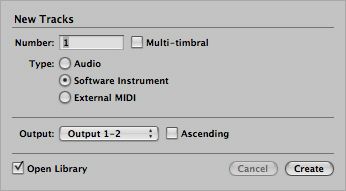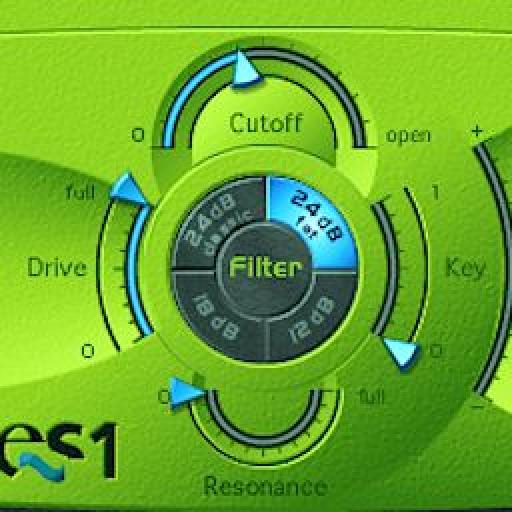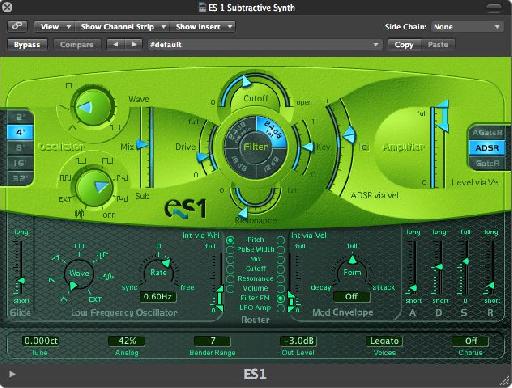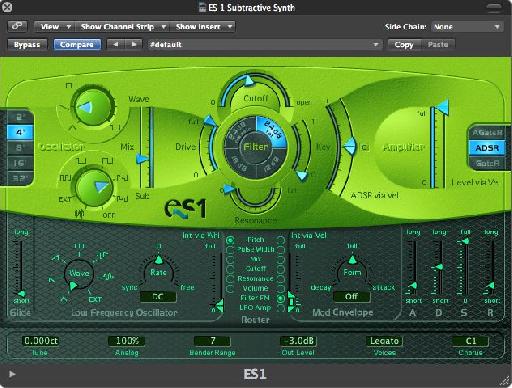In diesem kurzen Tutorial werden wir uns, wie man ein Synth-Sound aus einer aktuellen Pop-Hit, Lady Gaga "The Edge of Glory" zu reproduzieren sucht:
In diesem Fall, weil es eine ziemlich einfache Klang ist, werden wir mit Logic ES 1 softsynth der schwere Bass Synth-Sound hören Sie etwa 01.05 in den Song neu zu erstellen. Lassen Sie uns anfangen.
Schritt 1 - Einrichten der Logic-Projekt
Öffnen Sie Logic und starten mit einem neuen leeren Projekt mit einem leeren Software-Instrument-Spur:

Klicken und halten Sie auf dem Standard-EVP88 Instrument an der Spitze des Kanalzugs und wählen Sie 01

... Um die Standard-ES 1 Fenster zu öffnen:
Schritt 2 - Analysieren Sie die Sound-
Als nächstes wollen wir, um den Klang zu hören: es ist ein wenig schwer zu machen klar, wegen all der anderen Schichten in dem Song, aber der Bass spielt einfach ganze Noten (AEF #-D) mit einem ziemlich dunklen Klang ohne Filter Sweeps oder Wah-Wah-Effekte, im Gegensatz zu vielen Synth Bass-Sounds. Die Attack-und Decay sind kurz, aber nicht Ansatz einer gezupften oder perkussiven Klang. Genauerem Hinhören offenbart, dass die Geräusche von zwei Sägezahn oder quadratische Wellen eine Oktave auseinander, mit einer leichten Chorus besteht, und dass die Noten legato gespielt, so dass es keine Lücken zwischen ihnen.
Schritt 3 - Erstellen des Sound
Also hier ist mein ES 1 Version: (Klicken Sie auf das Bild unten, um eine größere Version zu sehen)
Überprüfen Sie die Einstellungen genau und tun Ihr Bestes, um sie so genau wie möglich wiederzugeben, wenn Sie tun, sollten Sie eine überzeugende Version des Lady Gaga zu hören ist.
Schauen wir uns einige dieser Einstellungen im Detail aussehen, damit Sie wissen, was los ist:
- First, the Sub oscillator is set to a staircase wave, which is a little richer than a sawtooth.
- We're using a straight sawtooth for the primary wave, which plays an octave higher than the Sub oscillator.
- Note that the Oscillator Mix slider is set so that we hear a bit more of the Sub than the Primary.
- Next, Drive is all the way up, to add a little more edge to the sound.
- The Filter is set to 24 dB, with no Resonance.
- The Cutoff to about 11 o'clock or so, to darken up the sound.
- Key is set to zero, so the filter stays at the same level throughout the keyboard range, and...
- Amplifier is set to Full to give us the maximum level. All the other modulation settings are set to zero, as we don't want any vibrato or tremolo in this sound.
- For the same reason, the Mod Envelope is set to zero.
- Next, note that the ADSR is set to a short Attack and Release, although neither are set to zero, which would add too much "snap" to the sound.
- The Decay is also fairly short, while the Sustain is set to its maximum, so the sound level doesn't drop off after the attack.
- Below that, Analog is set to 100% to add a little richness to the bass, and
- Voices are set to Legato, so to be sure that there are no gaps in the sounds when it's played.
- We've also added a little Chorus to add just a little motion to the sound.
Das Ergebnis
Hier ist, was es klingt:
[Audio-id = "7575"]
Beachten Sie, dass diese legato, dass jede Note wird, während die folgenden Note gespielt wird gehalten, so gibt es keine Performance-Lücke zwischen den Noten gespielt wird, und ich spiele diese beginnend mit dem "A" eine Oktave und ein Drittel unter dem mittleren C .
Schauen Sie sich die Logic ES2 Exposed Tutorial in den Griff zu Synthese in Logic und die bekommen Live 8 Designing Sounds für Dance Music und Live 8, die elektronische Dance Music von Olav Basoski, um Ihnen einen Vorsprung in Sound-Design für den elektronischen Bereich der Musik.





 © 2024 Ask.Audio
A NonLinear Educating Company
© 2024 Ask.Audio
A NonLinear Educating Company
Discussion
Want to join the discussion?
Create an account or login to get started!